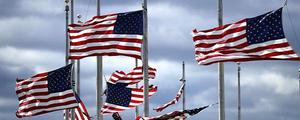GALLUP NEWS SERVICE
PRINCETON, NJ -- The percentage of Americans with a "great deal" or "quite a lot" of confidence in Congress is at 14%, the lowest in Gallup's history of this measure -- and the lowest of any of the 16 institutions tested in this year's Confidence in Institutions survey. It is also one of the lowest confidence ratings for any institution tested over the last three decades.
Gallup's annual update on Americans' confidence in institutions shows that confidence ratings are generally down across the board compared with last year. The public's confidence ratings in several institutions, including Congress, are now at all-time low points in Gallup's history of this measure. These low ratings reflect the generally sour mood of the public at this time.
Of the 16 societal institutions tested in Gallup's 2007 update, Americans express the most confidence in the military. They have the least confidence in HMOs and Congress. Americans have much more confidence in "small" business than in "big" business.
Basic Data
Gallup's annual update of the public's confidence in institutions -- conducted June 11-14, 2007 -- shows that all but 2 of the 16 institutions included in this year's survey have at least slightly lower confidence ratings than last year (although most of these changes are not statistically significant). The largest drops in confidence between 2006 and 2007 are eight percentage points for banks, the presidency, television news, and newspapers. There has been no change in the ratings of big business and HMOs.
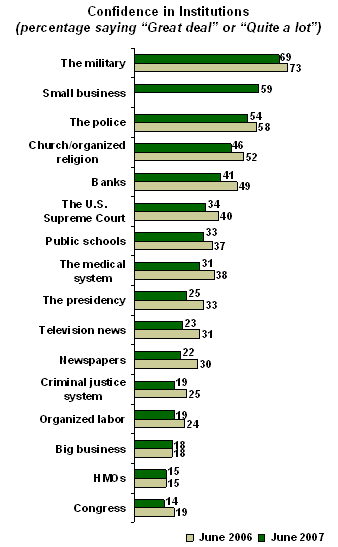
The drop in confidence in most institutions coincides with a period of time in which Americans have low levels of overall satisfaction with the way things are going in the United States, are giving Congress and President Bush low approval ratings, and are very negative about the direction of the economy. There is little doubt that this same "malaise" is reflected when respondents are asked to rate their confidence in the list of 16 societal institutions in Gallup's annual update. Whether these low ratings are becoming a permanent fixture of the American psyche or represent a short-term bout of public depression remains to be seen.
The general pattern of confidence in institutions has remained similar in recent years. There are three institutions tested this year in which a majority of Americans express a great deal or quite a lot of confidence: the military, small business, and the police. Two institutions tested have confidence ratings in the 40% range -- the church/organized religion and banks. All other institutions generate a great deal or quite a lot of confidence from less than 40% of the American population. The five institutions at the bottom of the list -- each with confidence ratings below 20% -- are the criminal justice system, organized labor, big business, HMOs, and Congress.
Congress and the Other Two Branches of Government
Confidence in the three branches of government -- executive (the presidency), legislative (Congress), and judicial (the Supreme Court) -- has been drifting downward over the past several years, following historically high ratings in the years immediately after 9/11.
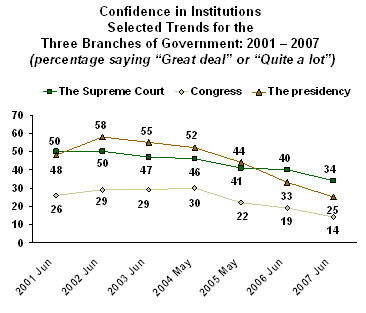
The current confidence rating for Congress -- 14% -- is the lowest in Gallup's history for that institution. Although ratings of Congress have never been high, they were at the 40% level at the time of Watergate in the 1970s, and again in 1986.
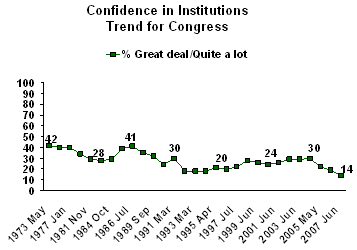
Americans' confidence in the presidency has dropped concomitantly with the drop in Bush's approval ratings. In 2002, 58% were confident in the presidency compared to the current 25%. President Bush's job approval ratings have fallen from 84% at the beginning of 2002 to 32% today.
At 34%, confidence in the Supreme Court, like Congress, is at its lowest point in Gallup's trend. Confidence in the Supreme Court has been at or above the 50% point at several times during the last several decades.
The Military
Americans' confidence in the military has always been relatively high, even in the mid-1970s during the aftermath of the Vietnam War. The military has been near or at the top of the list of institutions tested in each Gallup survey since 1987. The high point for the military -- 85% expressing a great deal/quite a lot of confidence -- came in March 1991, just after the first Persian Gulf War when the United States swiftly achieved its goal of driving Iraqi forces out of Kuwait. Even with this high point, confidence in the military has been nearly as high at several times since Sept. 11, 2001. The military's current 69% confidence rating, although still the highest of any institution tested this year, is the lowest for the military since 9/11.
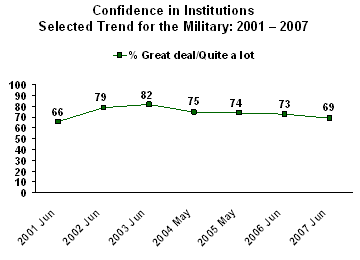
Big vs. Small Business
There is an enormous difference in Americans' confidence in business -- depending on the one-word adjective placed before the word "business" when the list is read to respondents. Only 18% of Americans express a great deal or quite a lot of confidence in big business, compared to 59% who express confidence in small business.
Confidence in big business has never been high, reaching its maximum of 34% in 1974. Even in the halcyon days of the dot.com boom in the late 1990s, only 30% of Americans expressed a great deal or quite a lot of confidence in big business. The current 18% confidence rating in big business is the same as last year, and remains the lowest in Gallup history.
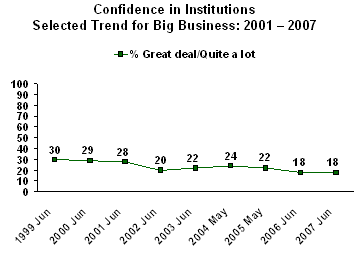
The Church or Organized Religion
The 46% confidence rating for the church/organized religion is within one percentage point of being the lowest in Gallup's history:
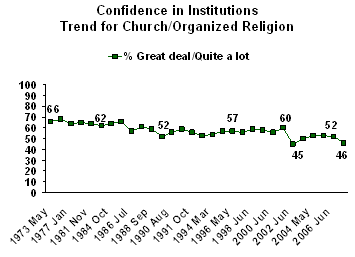
Ratings for the church fell significantly in the wake of revelations surrounding the priest abuse scandal in 2002, and before that had dropped in the wake of the television evangelism scandals of the late 1980s and early 1990s.
Confidence in the church or organized religion is particularly low among Catholics compared to Protestants. Confidence in the church or organized religion among Catholics was at 53% in 2004, and has dropped to 39% today. Among Protestants, confidence went from 60% in 2004, to 63% in 2006, to 57% today.
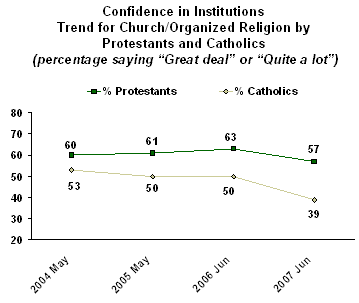
Journalistic Entities
Americans have relatively low levels of confidence in the Fourth Estate. Just 23% of Americans have a great deal or quite a lot of confidence in television news, and only 22% express the same sentiment for newspapers. Neither of these two entities has done exceedingly well in Gallup's history, but both are particularly low this year.
Bottom Line
Americans are currently in a very sour mood; a state of affairs that is reflected in the relatively low confidence ratings given many Americans institutions in Gallup's latest survey.
Confidence ratings for Congress are not only at the bottom of this year's list, but represent the lowest confidence rating in Congress in Gallup's history of using this confidence measure. This reflects a confluence of both the historically low standing of Congress in the minds of the public and the overall negative mindset of the American public.
Confidence in several other institutions is also at an all-time low point. We assume that the low confidence ratings measured this year are connected to Americans' broader malaise with the state of the country. It is not entirely clear what is behind the currently bad mood on the part of Americans, but Gallup analyses show that the Iraq war and the economy are certainly perceived as major problems at this point in time. The very low ratings for Congress suggest that Americans may be upset that their elected representatives have not been able to rectify these concerns as well.
Survey Methods
Results are based on telephone interviews with 1,007 national adults, aged 18 and older, conducted June 11-14, 2007. For results based on the total sample of national adults, one can say with 95% confidence that the maximum margin of sampling error is ±3 percentage points. In addition to sampling error, question wording and practical difficulties in conducting surveys can introduce error or bias into the findings of public opinion polls.
